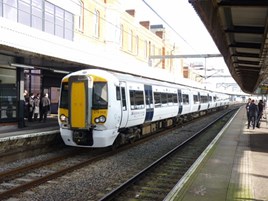The Long Term Passenger Rolling Stock Strategy for the Rail Industry is compiled by the Rolling Stock Strategy Steering Group. It includes analysis of future rolling stock needs by the original three rolling stock leasing companies (Angel Trains, Eversholt Rail Group and Porterbrook Leasing) and the Rail Delivery Group, which represent passenger and freight train operators and Network Rail. Latest figures exclude the very large numbers of new trains which will be built for London Underground in the coming years, the smaller quantities for international high speed services to and from London, and for light rail routes. But the most recent report, published in March, is consistent with the Government’s recent announcement about rolling stock requirements for the North of England.
The report includes projections for the quantities of new rolling stock that will be needed in the next five years that have been revised upwards because of the growth in passenger numbers.
These projections also reflect recent announcements regarding new trains, some of which have been announced, and some for which deals have not been concluded. These include:
- c2c (no confirmed deal).
- Thameslink (1,140 vehicles being built by Siemens for which the first arrives in August).
- ScotRail (for which 234 vehicles are being built by Hitachi for delivery from 2017).
- Caledonian Sleeper (75 carriages to be delivered from 2017).
- South West Trains (150 Class 707 vehicles built by Siemens, for which construction begins in June).
- Transport for London for the London overground (including 39 trains for the West Anglia Inners, for which no deals have been confirmed).
The strategy highlights the many customer benefits of electrification, including increased fleet reliability, improved train punctuality, better acceleration to shorten journey times, greater train capacity and reduced noise, vibration and emissions. It takes into account Government commitments, in principle, to continue to electrify the rail network (a commitment, it must be said, that was made before the May 7 General Election).
Taking into account the Government’s commitment in principle to continue the electrification of the network, the strategy forecasts the following:
- Based on forecasts of future passenger demand, an increase in the size of the fleet of between 52% and 99% will be required over the next 30 years.
- The proportion of vehicles using electric traction will rise from 69% today to 92-95% in 30 years’ time
- Between 13,000 and 19,000 new electric vehicles will be required over the period, with an average of between eight and 12 needing to be delivered every week. This is in contrast to four per week in the five years to April 2014. Around 3,350 new electric vehicles will be needed by April 2019, with orders already placed for 90% of this total. A further 428 vehicles for Crossrail, the Intercity Express Programme (IEP) and Essex Thameside have already been committed for delivery after this date.
This requirement for new electric vehicles is front-loaded. Updated analysis of fleet sizes in Control Period 5 (CP5) and CP6 indicates that 1,109 new EMU vehicles are now committed for delivery in CP5 (for England, Wales and Scotland and including TfL’s rail concessions), in addition to 2,240 vehicles for the Thameslink, Crossrail and IEP projects.
This makes a total of 3,349 new vehicles to be delivered in CP5. Orders have already been placed for 3,019, or 90% of these. This is compared with the total of 1,055 new vehicles delivered in CP4. The CP5 total could rise further as new franchises are let.
Richard Brown, chairman of the Rolling Stock Strategy Steering Group, said: “Demand for rail travel is set to continue to grow. Meeting this demand with the most suitable and cost-efficient rolling stock is vital to maximising the railway’s benefits for passengers, as well as the economy, local communities and the environment. This updated rolling stock strategy sets out future potential demand and identifies challenges and opportunities.
“The rail industry is committed to working with Government to ensure that a whole-life, whole-system approach to rolling stock is adopted. This will maximise both value for money and benefits for rail customers.”















Login to comment
Comments
No comments have been made yet.